Solid Oxide Fuel Cell Technology
Development of materials and infrastructure for the development of solid oxide fuel cell (SOFC) technology began in 1986 at then CSIRO Division of Materials Science under the leadership of Dr Sukhvinder Badwal. Ceramic Fuel Cells Ltd (CFCL), a CSIRO spin-off company, was established in 1992 to research, develop and commercialise the solid oxide fuel cell technology. It was based on the pioneering research and development performed at CSIRO into electrical, electrochemical and thermo-mechanical properties of high temperature ceramic materials based on zirconia.
Ceramic Fuel Cells Ltd is now a world leader in developing fuel cell technology to generate highly efficient and low-emission electricity from widely available natural gas. The company is listed on the London Stock Exchange AIM market and the Australian Securities Exchange (code CFU). Since 2010, CFCL has been marketing its BlueGen solid oxide fuel cell micro combined heat and power generation system.
BlueGen® is a grid-parallel SOFC system that operates on natural gas producing high efficiency electricity with up to 2kW power export and can also be used as a combined heat and power generation system. At peak efficiency, BlueGen delivers approximately 13,000 kilowatt-hours of low-emission electricity per year. BlueGen is fully remotely controlled and monitored via BlueGen net, with portals for customers, service companies and CFCL. In the future this function will allow BlueGen installations to be combined and controlled as virtual power stations, attractive for grid stabilisation when a significant volume of intermittent renewable sources feed into the grid.
Background to Fuel Cells
The basic principle of a fuel cell was demonstrated by Grove in 1839. Since about 1960, fuel cells have been under development and heralded as a replacement for current less efficient power generation technologies. Fuel cells and in particular high temperature fuel cells have several advantages over conventional fossil fuel based power generation technologies. They offer significant increases in the efficiency of conversion of chemical energy in hydrogen and fossil fuels into electricity – 60% (also at small sizes) compared with about 30-40% for normal thermal power generation. With heat recovery, fuel cell system efficiencies approach 80-90% as shown in the figure below.
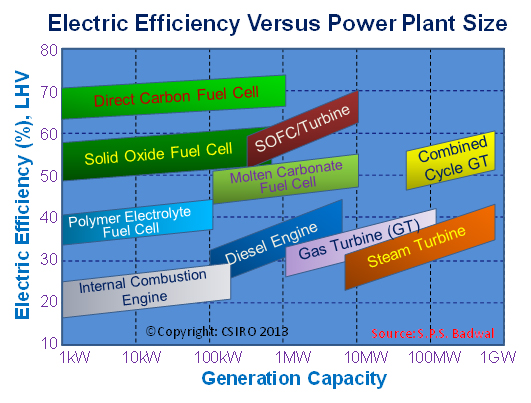
A number of different fuel cells have been under development for stationary, transport and portable power applications. They range in operating temperatures from room temperature to 1000°C with high temperature fuels cells such as solid oxide fuel cells having the ability to co-generate heat and electricity at load centres.
During the 1960s and 1970s, solid oxide fuel cells were investigated in major research programs, including overseas at Westinghouse, General Electric, and ABB, and in Australia by BHP and Aeronautical Research Laboratories. The technology was not commercialised as the materials and processing technologies available at the time were both poor and expensive.
Operating principle of a Fuel Cell and benefits
A fuel cell converts fuels (hydrogen, natural gas, methanol or gasified coal, etc.) into electricity electrochemically without the limitation of the Carnot cycle (Figure 2). A fuel cell consists of an electrolyte (solid, or a liquid or a molten mass held in a matrix) and air and fuel electrodes. It operates like a battery except that it continuously produces power, when supplied with fuel and air. In a solid oxide fuel cell, oxygen from air is converted to oxide ions, which migrate through an oxide ion conducting ceramic such as doped zirconia and react with the fuel. The electrons generated at the anode travel back to the cathode through an external load thus generating power.
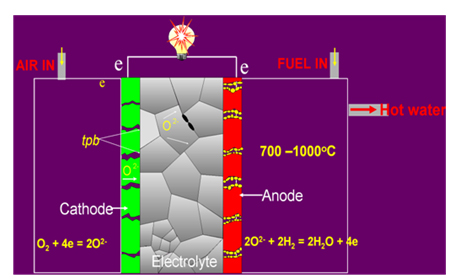
A single fuel cell generates about 1V when not under load and about 0.6-0.8V under load with operating current densities ranging to >500mA/cm². A number of these individual cells are stacked together in series / parallel configuration to produce a stack or a module (Figure 3).
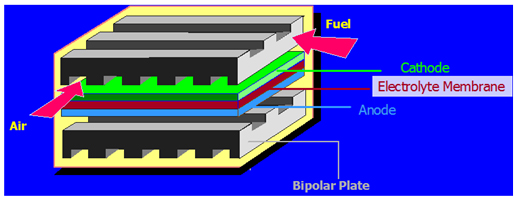
A fuel cell power plant consists of fuel processing, air feed, heat recovery, power conditioning sub-systems as well as a safety and over all control unit (Figure 4). Typically the fuel cell stack and all other sub-systems are housed in a single box.
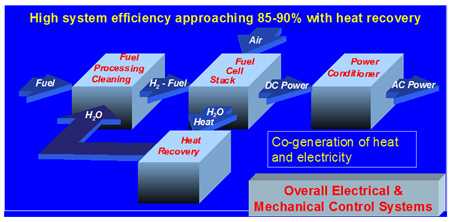
The modular construction and economies of scale of SOFCs would allow the installation of power plants in a variety of sizes. This meant that the fuel cell plants could be dispersed around the electricity grid, instead of coming from a massive power station. This would cut transmission losses as companies could generate their own power and sell excess capacity into the grid. Other benefits of solid oxide fuel cell technology include significant reduction in pollution and emission of greenhouse gases, generation of high-quality waste heat for cogeneration, and low noise and vibration levels. The cells can use a variety of fuels, but natural gas is best able to take advantage of the dispersed energy generation capability because it is already delivered via pipes to most industrial sites.
CSIRO Early Effort
Over a number of years, Dr Badwal was part of CSIRO’s research effort into oxygen sensing and zirconia-based ceramics. CSIRO had established excellent facilities for R&D on solid electrolyte systems (Figure 5). The researchers were at the leading edge of their field and had spun off a number of commercial applications during the 1970’s and 1980’s, including oxygen sensing equipment (see Oxygen sensor (SIRO2)) and a new ceramic known as transformation toughened partially stabilised zirconia.

Around 1983/84, in one of the strange episodes, the oxygen sensing research was almost closed down following an unfavourable science review by overseas experts. The reviewers believed that CSIRO’s low-temperature oxygen sensing work was heading down a dead-end and recommended it be stopped. However, CSIRO rejected the negative review following extensive evidence from the research team and success of early industrial trials, strongly demonstrating that the project strategy was very well thought out and correct. Dr Paul Wild, the then Chairman of CSIRO, was impressed enough with the research that he ordered it to be expanded to investigate other related technology areas.
Realising the potential of CSIRO’s intellectual property and technical capability and know-how in oxygen sensing and in thermal, electrical and mechanical properties of ceramic materials, Dr Badwal believed that CSIRO was best placed to develop the solid oxide fuel cells, a technology long recognised, in principle, for its high efficiency in electricity generation. Thus a small research effort on developing materials and infrastructure for the technology started under Dr Badwal’s leadership around 1986. Dr Mike Murray who was Leader (Officer-in-Charge) of the Advanced Materials Laboratory, strongly believed in increasing awareness of CSIRO’s capability, to develop this exciting technology, in both public and private sectors in Australia. In 1986 a brochure on the technology was produced by Drs Murray and Badwal and mailed out to a range of companies. However, these early efforts proved difficult due to the large investment required and a general scepticism about Australia’s capacity and capability of delivering a rather large and complex project through to commercialisation.
Consortium Approach
Around 1989 CSIRO was beginning to market the benefits of research more aggressively and there was less emphasis on curiosity-driven research.
In 1989, Drs Badwal, Murray and Föger took a more systematic and planned approach to their marketing. Dr Murray commissioned a marketing study by Ecogen, which indicated a potential future market of several hundred million dollars in Australia alone and substantially higher globally.
A new brochure was produced that talked a little bit about the technology but put more stress on its market potential, and CSIRO’s research capability. It was then sent to various utilities and other target companies followed up with presentations and discussions with interested groups. CSIRO support and backing from Division Chief, Dr Mike Murray, all the way through to CSIRO CEO, Dr John Stocker, gave the effort enormous credibility.
Industry champions emerge
A critical breakthrough came following a presentation to the Victorian Government’s Strategic Research Foundation (later on changed to Strategic Industry Research Foundation – SIRF). A BHP executive, Dr John Parrott, chaired a SIRF sub-committee on Minerals and Energy, and he became very interested when he was made aware of CSIRO’s efforts. Dr Parrott had previously come across the technology when working in Japan, where Mitsubishi had begun research in the field. Through Dr Parrott, BHP became interested and provided support with market assessments, and its interest encouraged other companies.
One of Pacific Power’s (ELCOM at the time) executives saw a presentation given by CSIRO on the fuel cell technology at a conference in December 1989 and arranged a meeting with another senior executive, Mr John Wiedermier and his senior staff. Mr Wiedermier became a key supporter of the project and was a founding Board Member.
Following a talk by Dr Badwal at a Commission for the Future Round Table on Energy Efficient Technologies in March 1991, Energy Research and Development Corporation (ERDC) also decided to join discussions on the establishment of a company structure and became a strong supporter. There was general consensus that the best route forward was to establish a consortium to spread the risk. Pacific Power’s enthusiasm, plus that of BHP, fed the interest of others such as the then Victoria State Electricity Commission, the Gas and Fuel Corporation, Shell and SIRF.
From a consortium to a company
The Minerals and Energy sub-committee of SIRF recommended solid oxide fuel cell technology as a key area for strategic R & D in Australia. With ten to twelve parties now taking an active interest, the next phase was to create a formal structure for the consortium. The commercial partners had a very firm view of what they wanted.
The initial plan was to undertake the research and development inside CSIRO, however, the partners preferred a separate structure to provide clear focus on technology development and commercialisation. Under CSIRO and SIRF facilitation, a consortium was subsequently formed. A marketing study was commissioned by consortium partners and CSIRO’s credentials and capability to carry out research and development in the fuel cell area was verified through visits to many overseas groups. With excellent feedback and positive outcome of the marketing study undertaken by McLennan and Magasanik group, R & D formally commenced at CSIRO in April 1991. Following this, a detailed research plan and budget were prepared. The company, Ceramic Fuel Cells Ltd, was launched in December 1991 by the then Commonwealth Minister for Resources, the Hon Alan Griffiths, and was attended by State Energy Ministers from Victoria and NSW.
Dr Badwal was appointed Director R&D and Chief Operating Officer and Dr Föger, Deputy Director R& D. After the first Chief Executive resigned, Dr Parrott took over in March 1993 and remained CEO to mid 1997. Mr Peter Coates CBE, who at the time was Executive Chairman of Davey John Brown, was appointed founding Chairman of the Board of Directors. He was a much needed stabilising influence throughout the first five-year phase.
The company finally started operating in 1992, with CSIRO, BHP, Pacific Power, Energy Research and Development Corporation and SIRF as the founding members. CSIRO seconded a number of key staff to help transfer the technology and provide much needed expertise in several critical areas. Other consortium partners (SECV, SECWA, ETSA, QTSC and ECNZ) joined later on and provided additional R&D funding.
A fifteen year time frame leading to technology commercialisation was considered quite reasonable. The budget to carry out the first five year R & D program, leading to a clear demonstration of proof-of-concept at the 3-5kW stack level, was estimated at Aus$30 million. It was agreed that the Consortium partners would commit to funding this first R & D phase. Dr Murray played a crucial role in ensuring that CFCL had the full backing of CSIRO as CSIRO’s infrastructure support and intellectual property were a crucial component of the success of the project.
Putting together a strong team
A number of researchers and engineers were employed and collaborations were established with other research organisations and Universities in key strategic areas. A well integrated team was established and the R&D proceeded in a highly focused effort. The team grew from fifteen CSIRO and three BHP R&D staff at the start of the Company to over 70 (as the company attracted its own employees) by the time the first five-year phase was completed in June 1997. Excellent fuel cell diagnostic, testing and component fabrications facilities were established (Figures 6 & 7) and were crucial to the success of the company.
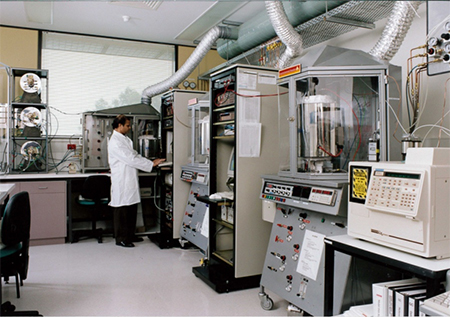
Very strict management procedures were put in place to provide focus to technology development. At the start of the project in 1992, each technology area was reviewed through brain-storming sessions to generate ideas to solve problems, and to decide which problems were critical and which technologies would achieve a commercial outcome. These brain-storming sessions continued throughout the five-year phase. The overall company program was divided into several discipline-based projects each led by a project leader. Each project team had responsibility to achieve strict milestones which were tied to the overall Company Technology Development Plan.
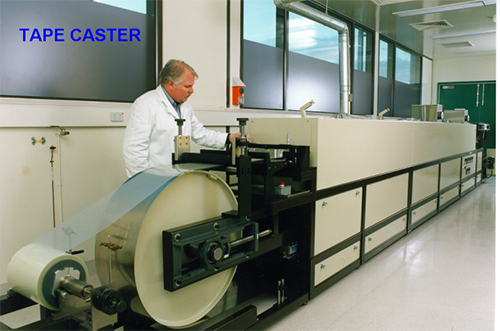
A formal approach to planning was taken. The five-year R&D plan cascaded down to 12- month operational research plans. Every researcher’s personal performance objectives were driven by the current operational plan. In order to keep track of the technology, and to provide overall coordination for the program, each project area was reviewed on a monthly basis. Major reviews were held every six months and the plan and personal objectives updated accordingly. All the research results were documented in six-monthly reports and intellectual property reports. This process also helped record and protect any intellectual property developed along the way.
Cross Project Teams, to address particular issues and on achieving major Company milestones, were established. This process also provided cross fertilisation of ideas between researchers working in different areas. There was little effort towards exploring areas of scientific curiosity.
During the first five year R&D phase, the Company was expanding rapidly and running short of laboratory and office spaces. The company was continuously designing, building and upgrading laboratories and new equipment. New laboratories were initially built at Monash Science and Technology Park at Clayton and CFCL was also conducting R & D at CSIRO. Fuel cell modelling work was carried out at BHP Research Laboratories. A purposely designed building was constructed at Monash University Churchill campus in the Latrobe Valley with the support of SECV, Latrobe Regional Commission and Monash University (Figure 8).
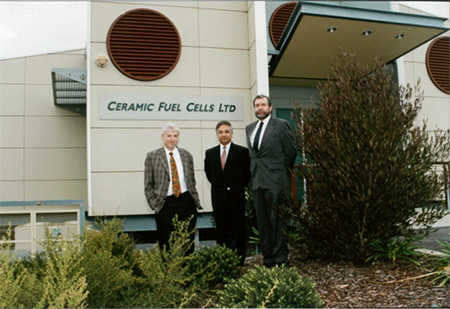
The building hosted fuel cell component fabrication scale-up facilities including a clean room, commercial tape caster, screen printing equipment for electrode fabrication, large furnaces and laboratories and infrastructure for testing of several large fuel cell units in the kW range simultaneously (Figure 9).
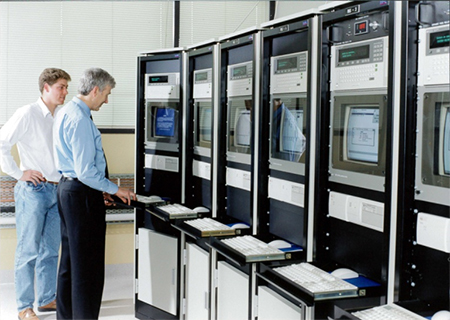
For four consecutive years, technical milestones were brought forward, after having met or exceeded objectives set in the previous year. During the last two years of Phase I, when the Project had greater success in achieving its technical milestones, several new milestones were introduced. These related to the scale-up and semi-commercialisation of the technology.
The Company also kept close track of the activities of overseas competitors. There was regular interaction with researchers at Siemens, Mitsubishi, Westinghouse and others, although each group carefully avoided giving away any commercial secrets.
Results exceed projections
The effort and dedication of staff paid off. After five years, the project was not only on budget, but had achieved far more than had been originally projected. Not only had the Company assembled and demonstrated its major milestone, a 3-5kW fuel cell stack in 1997 (Figure 10), it had developed state-of-the-art infrastructure and facilities along with well trained scientists and engineers which all formed an excellent platform for launching CFCL into the next phase.

The decision to locate outside CSIRO in a separate corporate entity proved correct in that it provided a strong focus to the research and development. Following completion of the first successful R & D phase, the company acquired much larger premises at Browns Road Noble Park in 1997 to embark on technology consolidation, systems development, establishing production facilities and to develop commercial prototypes. In 2000 CFCL decided not to extend the lease on the Churchill facility and to consolidate in Noble Park. Dr Badwal continued his association with the company as a General Manager, Technology Strategy until 1999 and then returned to CSIRO.
Around this time, the Company decided to operate independently of CSIRO. Dr Badwal returned to CSIRO and continued R&D on other energy systems including polymer electrolyte membrane fuel cells, ceramic and polymer membrane technologies for hydrogen and oxygen generation and gas separation, and direct carbon fuel cells. Dr Föger resigned from CSIRO and joined the company in 1999, first as General Manager Technology Development and then from 2001 as Chief Technology Officer. In this role, he has ensured that the original passion, vision and entrepreneurial spirit bequeathed from CSIRO have lived on into the future of CFCL.
The first 5 years to 1997 were meticulously planned and proceeded with secured funding and clearly defined technical milestones. However, due to uncertainty of funding beyond 1997, CFCL strategy on how to proceed beyond the first five year phase faced many challenges. CFCL was converted to a share holding Company in 1999 and was listed on the Australian and London stock exchanges in 2004 and 2006 respectively. To date the company has spent over A$300 million and employed on average about 100 staff throughout its life.
Early in 2003 CFCL was aiming to develop and commercialise large systems in the 100-200kW range. However, due to the high cost of building, evaluating and field testing large systems, Dr Föger convinced the CFCL Board later that year, to adopt a strategy (that had been considered and rejected by the Board earlier) to develop systems in the range 1 to 5 kW for the residential and small commercial market. In doing so, systems development on the current BlueGen unit was initiated in ernst. By the end of 2005 CFCL installed the first field test units in Melbourne and in Oldenburg, Germany.
Early field testing provided invaluable feedback for further development. In April 2009, after 17 years of hard work with many financial and technical challenges, and 3 generations of field test units since 2005, CFCL presented its first pre-commercial system (BlueGen) at the Hannover Fair. A CE and MCS certified product followed in April 2010. The development history is summarised in Figure 11. More information on BlueGen system is available at www.cfcl.com.au.
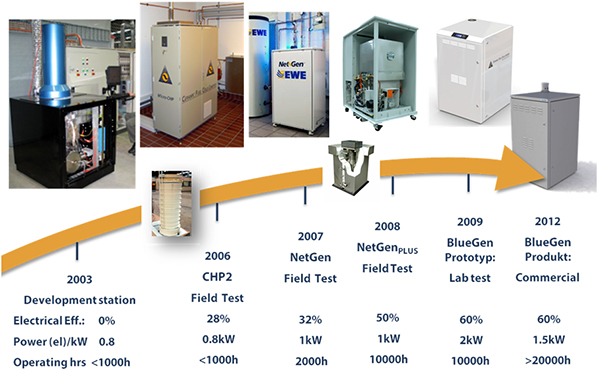
In 2006, the company had decided to focus on European market and set up its manufacturing and commercialisation Centre in Germany. The centre for innovation, carrying out R&D and product development, was to remain at Noble Park in Melbourne (Figure 12).
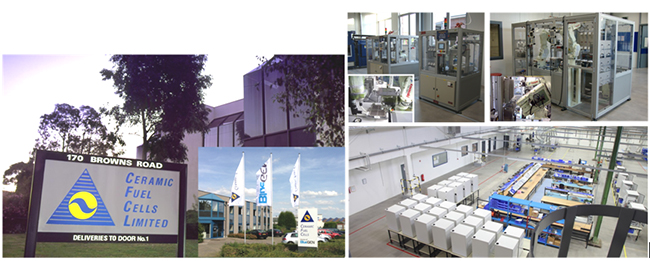
In early 2012, CFCL started commercial sales of BlueGen units in its core European markets primarily through distribution partners. To date about 400 CFCL micro-CHP systems are operating with customers, the largest number in Germany, and the numbers increase steadily from month to month (Figure 13).
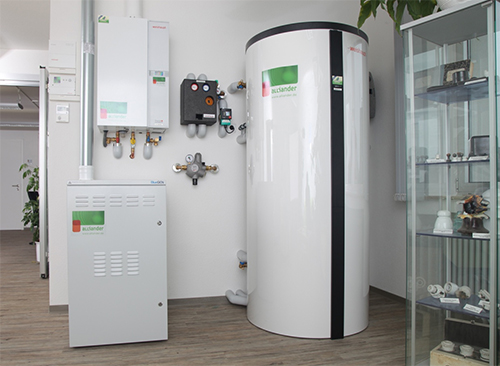
In summary, the 21 years since the formation of CFCL in 1992 have been a long, stony and often frustrating journey. However, in spite of all the difficulties, CFCL has remained a world leader of SOFC technology, ahead of much larger, better resourced, international companies. Its product, BlueGen, has been developed by a relatively small but dedicated team of world class scientists and engineers under the leadership of Dr Föger whose perseverance and drive towards a clear vision and objectives has brought SOFC technology to reality. Importantly too the company has been supported throughout by patient long term investors.
Honours and Awards
Scientists involved have received the following recognition: Dr SPS Badwal, and Mike Murray, a Centenary Medal in 2001; Dr Badwal Appointed a CSIRO Fellow in 2013; and Dr Manh Hoang, won the Sir Ian McLennan Achievement for Industry Award in 2013.
CSIRO Team that contributed to CFCL’s establishment:
Dr Sukhvinder Badwal, Dr Mike Murray, Dr Karl Föger
CSIRO Team that contributed to CFCL’s technology:
Dr Sukhvinder Badwal, Dr Karl Föger, Dr John Drennan, Dr Manh Hoang, Richard Donelson, Fabio Ciacchi, John Newman, Dr David Hay, Dr San-Ping Jiang, Dr Paul Callus, Daniel Graham, Kylie Crane, Kristine Giampietro, Keith Wilshire, Bob Johnson, Natasha Wright (nee Rockelman), Viktor Zelizko, Dr Anselm Oh, Bob Hughan, Dr Mark Trigg, Dr Rob O’Donnell, Tom Behrsing, Dr Yvone Duan, Alex Yam, Dr Alan Morton, Dr Tracey Johnson, Mr Robert Wilson.
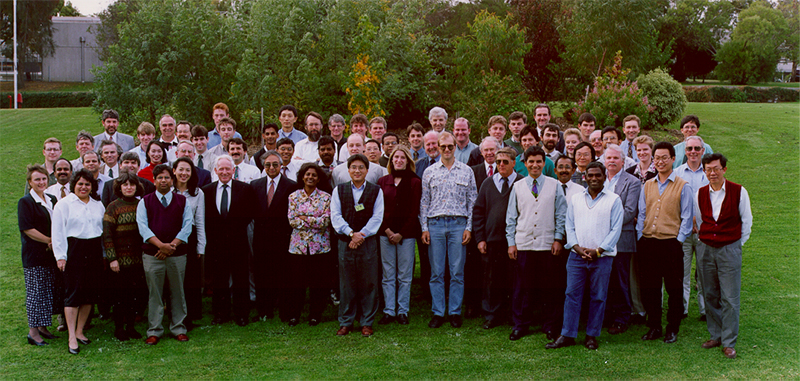
Source
- Dr S.P.S. Badwal, 2013, personal communication
Related Information
- Beyond Science ‘ managing projects for success, CSIRO publication, 1998
